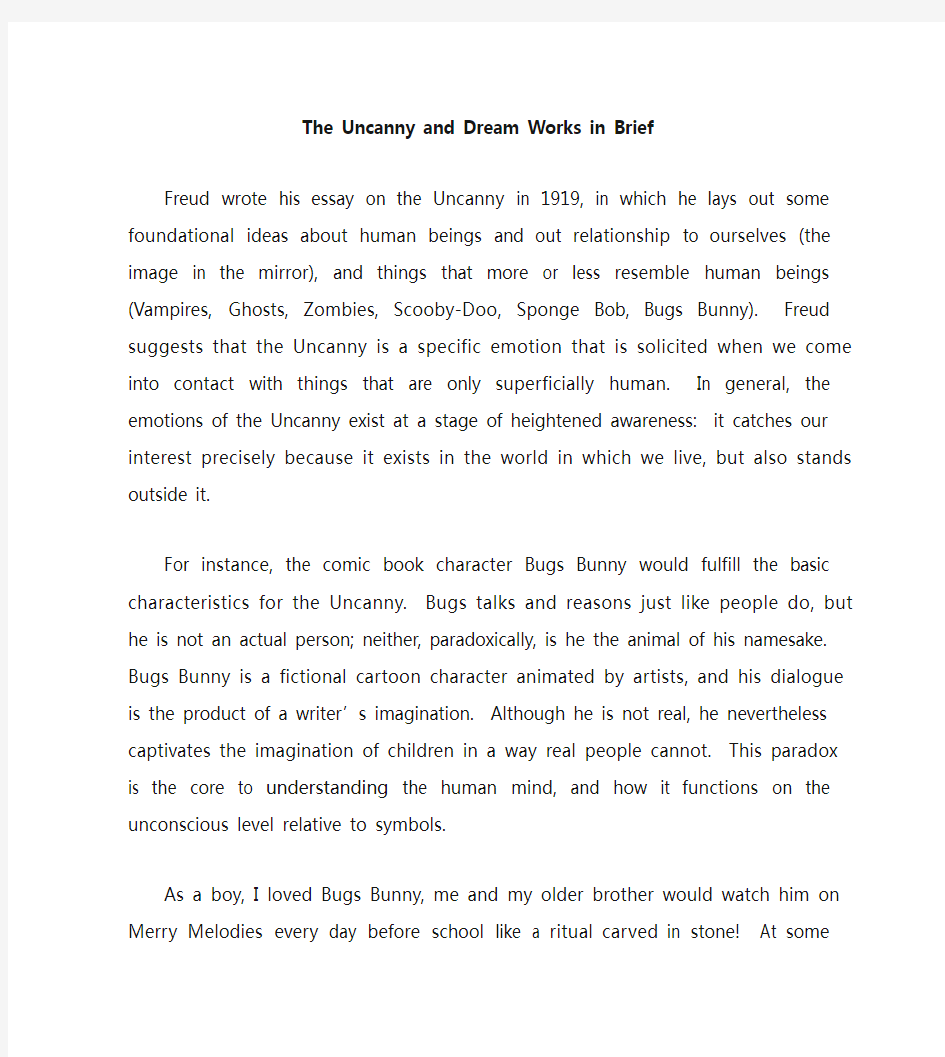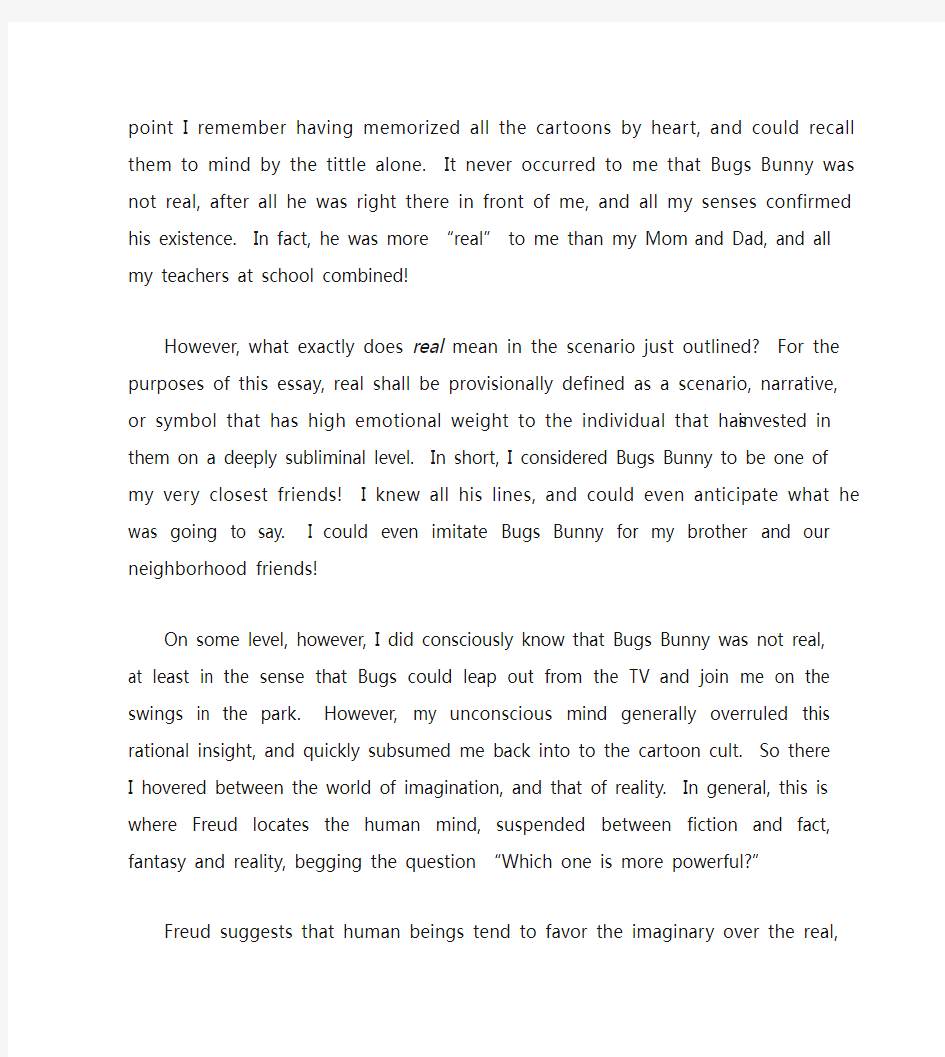TheUncanny


The Uncanny and Dream Works in Brief
Freud wrote his essay on the Uncanny in 1919, in which he lays out some foundational ideas about human beings and out relationship to ourselves (the image in the mirror), and things that more or less resemble human beings (Vampires, Ghosts, Zombies, Scooby-Doo, Sponge Bob, Bugs Bunny). Freud suggests that the Uncanny is a specific emotion that is solicited when we come into contact with things that are only superficially human. In general, the emotions of the Uncanny exist at a stage of heightened awareness: it catches our interest precisely because it exists in the world in which we live, but also stands outside it.
For instance, the comic book character Bugs Bunny would fulfill the basic characteristics for the Uncanny. Bugs talks and reasons just like people do, but he is not an actual person; neither, paradoxically, is he the animal of his namesake. Bugs Bunny is a fictional cartoon character animated by artists, and his dialogue is the product of a writer’s imagination. Although he is not real, he nevertheless captivates the imagination of children in a way real people cannot. This paradox is the core to understanding the human mind, and how it functions on the unconscious level relative to symbols.
As a boy, I loved Bugs Bunny, me and my older brother would watch him on Merry Melodies every day before school like a ritual carved in stone! At some point I remember having memorized all the cartoons by heart, and could recall them to mind by the tittle alone. It never occurred to me that Bugs Bunny was not real, after all he was right there in front of me, and all my senses confirmed his existence. In
fact, he was more “real” to me than my Mom and Dad, and all my teachers at school combined!
However, what exactly does real mean in the scenario just outlined? For the purposes of this essay, real shall be provisionally defined as a scenario, narrative, or symbol that has high emotional weight to the individual that has invested in them on a deeply subliminal level. In short, I considered Bugs Bunny to be one of my very closest friends! I knew all his lines, and could even anticipate what he was going to say. I could even imitate Bugs Bunny for my brother and our neighborhood friends!
On some level, however, I did consciously know that Bugs Bunny was not real, at least in the sense that Bugs could leap out from the TV and join me on the swings in the park. However, my unconscious mind generally overruled this rational insight, and quickly subsumed me back into to the cartoon cult. So there I hovered between the world of imagination, and that of reality. In general, this is where Freud locates the human mind, suspended between fiction and fact, fantasy and reality, begging the question “Which one is more powerful?”
Freud suggeststhat human beings tend to favor the imaginary over the real,precisely because it has far greater emotional appeal. If Bugs Bunny had invited me into his cartoon world, for instance, I would have joined him in a heartbeat. Yet that was never really possible, even though it would have seemed perfectly reasonable to me at the time. Now as an adult, I know that the station played Bugs Bunny every morning before school in order to shamelessly hawk me sugary breakfast cereals, cookies, candies, and lunch box ring dings that I would constantly nag my mother to buy. My good friend Bugs, it seems, was a con man in disguise.
The concept of disguise is a psychological trope commonly featured in the Psychoanalysis of the Uncanny, and represents the preliminary of Freud’s magnum opus, the Interpretation of Dreams (1899). In brief, in the Interpretation of Dreams, Freud states the basic goal of dreams is wish fulfillment: the ability to achieve in the dream state desires that cannot be actualized in the waking state. Many of the desires pursued in dreams are aggressively violent and sexual in nature, and as such are reprehensible to the Conscious mind. This may in part explain why it is so difficult to remember certain dreams, because the conscious fears the subject matter enough to repress them back into the unconscious mind.
In essence, for Freud the dream comes in two basic components: the manifest dream and the latent dream. The manifest dream is the literal component of the dream, the images you remember directly upon waking. The Latent dream is the submerged part of your dream that contains emotionally stressful content your conscious mind cannot experience directly; hence, it is hidden in disguise. The job of the Pscyhoanalysist is to understand these distinctions, and help the patient surface the real content of the dream and make it available to their conscious mind hence resolving the underlying anxiety (a trauma that generally occurred in childhood).
Freud used the term Dream Works to identify the manner in which the unconscious mind conceals trauma in dreams from the conscious mind, and listed four basic processes at its control.
?Condensation– one dream object stands for several associations and ideas;
thus "dreams are brief, meager and laconic in comparison with the range and wealth of the dream-thoughts."
?Displacement– a dream object's emotional significance is separated from its real object or content and attached to an entirely different one that does not
raise the censor's suspicions.
?Representation– a thought is translated to visual images.
?Symbolism– a symbol replaces an action, person, or idea.
A dream can deploy one, two, three, or all four processes to a dream in order to render stressful content inert to the conscious mind.
An analogy might suffice here by recourse to the world of popular culture, musical lyrics and censorship. Certain words cannot be spoken over a radio broadcast because they are deemed offensive and harmful to the general public. As a result, many musical artists conceal the real meaning of their song lyric into generalized euphemisms like using the word “rock” for “fuck.” Thus, when the lyrics say “Oh baby I want to rock you all night long,” it is stating one thing while implying something else entirely. If we were using the concept of Dream Works to analyze this musical example, we can conclude that the word fuck was displaced by the more generic term rock that does not directly raise the censor’s suspicions; or, the production company might graft the sound of a dog barking or car horn blaring over lyrics that are deemed offensive.
